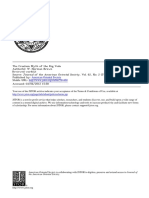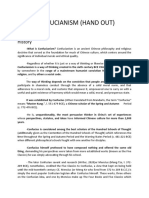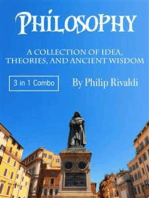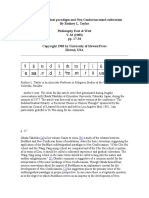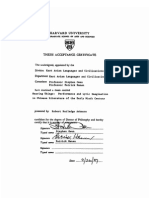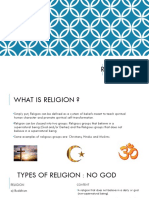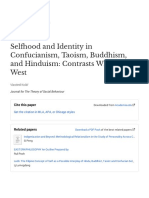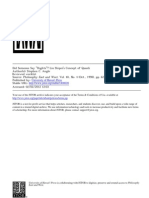Book Reviewby Joseph A. AdlerKenyon College
China Review International
, vol. 10, no. 2 (2003)
The Confucian Body
Thomas A. Wilson, ed.
On Sacred Grounds: Culture, Society, Politics, and the Formation of the Cult of Confucius
. Harvard East Asian Monographs 217. Cambridge and London: Harvard University AsiaCenter, 2002. xvi, 424 pp.
Hardcover $45.00, ISBN 0-674-00961-4.There was a time, as late as the first half of the twentieth century, when Western academic readerswere likely to come across the statement that Buddhism was not a religion, but rather a secular systemof philosophy or mental cultivation. Such a claim would be based on a very selective reading of Buddhist texts; an absence of other kinds of investigation, such as observation of Buddhist practicesother than meditation; and a set of assumptions about what constitutes religion that was based on aWestern, primarily Christian, standard. When religion is defined as belief in a supreme being, for example, Theravada Buddhism clearly falls outside that category – especially if one limits investigationto normative religious texts. (Asking ordinary lay Buddhists in Sri Lanka what they believe might yield different conclusions.)Those days are, happily, over. Western understanding of Buddhism has grown broader and deeper,while implicit theological agendas informing scholarship, when they exist at all, are no longer assimplistic as they once were (although they will probably seem so to our successors). But to thosescholars who consider Confucianism to be a religious tradition (and I am one), the current state of scholarship may still seem like the dark ages. Precisely the same conditions that gave rise to themisunderstanding of Buddhism in the past are today continuing to reinforce old notions of Confucianism as merely a socio-ethical-political system of thought. We occasionally find this even insophisticated sinological scholarship on Chinese religions.
(1)
Further reinforcement often comes fromChinese from the People’s Republic – where there are five officially-recognized religions and Confucianism is not one of them – many of whom have grown up under a regime that had very specificthings to say about Confucianism.There are two ways of examining this question, one falling roughly under the humanities disciplines and the other under the social sciences. The humanities approach often starts by proposing or choosing adefinition of religion and then proceeds to demonstrate that Confucian writings – not limited to the
Analects
or the Classics – display the necessary characteristics of a religious tradition. An example of this kind of approach is Rodney Taylor’s collection of essays,
The Religious Dimensions of Confucianism
(Albany: SUNY Press, 1990). Taylor, relying primarily on Frederick Streng’s definitionof religion, shows convincingly that Confucianism can usefully be analyzed as a "means of ultimatetransformation," the goal of which is Sagehood, defined with reference to the transcendent realm of Heaven. This approach relies primarily on phenomenology and hermeneutics to analyze and interpretthe religious meanings of Confucian texts and to situate them in the discursive framework of the cross-cultural study of religion.The majority of the essays in
On Sacred Grounds
address the question of the religious dimensions of Confucianism from a social science perspective. Four of the contributors, including the editor, arehistorians; the others represent the fields of anthropology, journalism, history of music, history of art,and religious studies. The general aim of the collection is "to return ritual (as theory and practice) to our thinking about Confucianism" (p. 35) and to "draw attention to Confucianism’s corporeality and religiousness" (p. 36), and in these respects it succeeds admirably. As the title suggests, the centralfocus of the book is really the Confucian temple as the chief ritual site. The cluster of specific topicsaround this focus includes the music that always accompanies Confucian ritual; the mythic and iconographic figure of Confucius, who is the chief recipient of ritual sacrifice; his flesh-and-blood
The Confucian Bodyhttp://www2.kenyon.edu/Depts/Religion/Fac/Adler/Writings/Wilson.ht1 of 907/03/2009 16:54

descendants (the Kong family), who during Imperial times were responsible for keeping the cult alive(in exchange for extraordinary state-mandated favors and wealth); and the politics surrounding thetemples, especially in the Ming dynasty and the early years of the People’s Republic. By fleshing outthese aspects of the history of Confucianism,
On Sacred Grounds
demonstrates in very concrete waysthat the tradition has all the characteristics usually associated with religions, and it does so withoutrelying on any specific definition of religion. In other words, it demonstrates that Confucianism isreligious by anyone’s definition. In this respect it may turn out to be more convincing than a moretheoretical or phenomenological approach – especially to historians, many of whom, in excludingConfucianism from the category, uncritically assume a common-sense, Western-based definition of religion that automatically excludes other models.Thomas Wilson, the editor of this collection, is a historian who is a notable exception to the abovegeneralization. Although he doesn’t explicitly discuss the category
per se
, he clearly understands thatConfucian religiousness differs from the Western model. In his Introduction Wilson correctly identifiesthe roots of the "problem" of Confucian religiousness as the Western tendencies (1) to privilege the
Analects
instead of reading a wider corpus of Confucian texts, starting with the
Shijing
(Classic of Odes) and the
Liji
(Record of Ritual), (2) to read the
Analects
"in the service of Western philosophicaland theological agendas," and (3) to ignore or fail to recognize the centrality of Confucian ritual theoryand practice, such as liturgical song and sacrifice (pp. 12-13). Wilson nicely captures the moral and philosophical implications of this perspective in pointing to "Confucius’s acute sense of the breakdownof the cosmic (as well as the social) order of things as he witnessed the degradation of the rites that helamented in Book 3 of the
Analects
" (ibid). It would be difficult to argue that such a reaction (assumingfor the moment that the
Analects
accurately represents Confucius’s thinking) was based on anunderstanding of ritual as merely a means of enforcing social order. Confucius’s innovation was not aturn from religion to philosophy but rather a philosophical deepening of a fundamentally religiousworldview.Wilson briefly unpacks the history of the misperception of Confucius as a kind of rational skeptic byfocusing on the theological agendas of the early translators of the Chinese classics, such as the16th-17th century Jesuit missionaries, and the 19th-century Protestant missionary James Legge. Leggeconsidered Confucius to be a skeptic, but he also believed that the imperial sacrifices to Heaven preserved "vestiges of an underlying monotheism" (p. 6). In other words, the Chinese had been earlyrecipients of divine revelation which had nearly been lost, so it was appropriate that the missionariesrestore to them their own ancient tradition and its later (Christian) developments. Understanding theorigins of the Western heritage of Confucian scholarship obviously sheds light on the "conventionalwisdom" that prevails today. One point that Wilson omits is the use of the word "classic" to translate
jing
– the same word rendered (in Sanskrit) in a Buddhist context as
sutra
and in a Chinese-Christiancontext as "scripture" (e.g. the title of the Bible,
Shengjing
, "Holy Scriptures"). The so-called Confucian Classics are sacred scriptures, and it is indeed unfortunate that "Classic" has become soentrenched that even scholars who should know better -- such as myself – continue to use it.
(2)
Wilson’s chapter, "Ritualizing Confucius/Kongzi: The Family and State Cults of the Sage of Culture inImperial China," is a very thorough history of these cults, although he does not continue the story intothe Taiwan phase of the Republic of China. (Taiwan does not even appear in the book’s index,although it is treated in Joseph S.C. Lam’s chapter and mentioned in a few others.) The "family cult"refers to the worship of Confucius as an ancestor by his lineal descendants, primarily at his home town,Qufu, in Shandong province. This was not simply a family affair, as it was supported and largelyregulated by the state. The story is a long and very interesting one, which I will not try to summarizehere. The state cult was regulated by the Ministry of Rites as part of its authority over the entireimperially-sanctioned pantheon of deities. In addition there were temples and shrines to Confucius at private academies, whose scholars worshipped Confucius as something like the patron deity of their profession (much as printers, shoemakers, and other professions had their own patron deities).The establishment of Confucianism as "orthodoxy," as Wilson demonstrates, was a multi-dimensional
The Confucian Bodyhttp://www2.kenyon.edu/Depts/Religion/Fac/Adler/Writings/Wilson.ht2 of 907/03/2009 16:54
process that developed and was refined continuously over a two-thousand year period, in constantdialogue with religious, political, and social factors. The dimensions of this process included ennoblement (the granting by the state of mostly-posthumous titles of nobility), the granting of other official titles (e.g. Confucius as "Supreme Sage and First Teacher"), enshrinement in the state-supported Confucian temples, regulation of the forms of enshrinement (e.g. with statues or name plaques),regulation of the forms and liturgies of sacrificial ritual at the temple, the development of the civilservice examination curriculum, and the printing of classics and commentaries by the state.Ennoblement and enshrinement, in particular, went through so many changes that a tabular presentation might have been easier for the reader to digest than the story in prose. Confucius, hisdisciples, his later followers, his descendants, and his ancestors were all, at various times, given officialtitles (which were frequently changed), installed in and sometimes removed from the temples, had their locations in the temples changed, and so forth.Following Wilson’s "Ritualizing Confucius" is Deborah Sommer’s "Destroying Confucius: Iconoclasmin the Confucian Temple," which focuses on the Ming dynasty debate over whether the sages (
sheng
),correlates (
pei
), wise ones or savants (
zhe
), and worthies (
xian
) in the imperial Confucian temples inthe capital and provinces should be represented by sculpted images, as they had been, or by simple"spirit plaques" (
shenwei
) – painted wooden plaques, usually about three feet high and eight incheswide (my estimate), giving the currently-official posthumous title of the person in question. The MingEmperor decided in 1530 to have the images destroyed, and to this day only spirit plaques are found inConfucian temples – except for the one at Qufu, where Confucius is worshipped by his descendants asan ancestor.Sommer, whose field is religious studies, focuses on the phenomenological elements of the debate, and this chapter nicely complements the one by Huang Chin-shing, who covers some of the same ground from a political perspective. Sommer also has the sharpest focus on the "corporeality" of Confucianism,in the very literal sense of beliefs concerning the blood and
qi
connection between Confucius and hisdescendants; the "liminal status of images (both imagined and concrete)" (p. 97), standing between theworld of living human bodies and the invisible world of the spirits; and the mediating function of sacrifice as communication across the "continuum between the living body of flesh and bones and the body transformed by the passage into death and beyond, into the spirit world" (p. 98). She outlinesthree ritual modes of representation of this liminal phase: visualization of the deceased by filialdescendants; the "personator" of the dead – "a young descendant of the deceased who temporarilyadopted the identity of the recently departed and participated as a guest of honor in a commemorativefunerary meal" (p. 101); and the painted or sculpted image. The continuity of the psycho-physical-spiritual body across the life-death continuum, as descendants communicate with and later becomeancestors, embodies the all-important continuity of the family line through the generations.The non-duality of body and spirit (or mind), which is the fundamental concept in Chinese "natural philosophy," does not mean that no distinctions are made between the two. Sommer shows thatintellectuals as far back as the Song dynasty, such as Su Shi and Cheng Yi, had noted thatrepresentational images could never capture the spirit of a deceased ancestor as well as an imagined image. Since representation, along with sacrifice, was a means of communication between the realms,an inaccurate representation would be a note of disharmony that would not only show disrespect for thedead but could also have concrete repercussions for the living. This argument was taken up and developed further in the Ming by Qiu Jun, a high official whose views were influential during theculminating phase of the debate under the reign of the Jiajing emperor (r. 1521-66), who ordered thedestruction of the images. The exemption of the images at the ancestral temples in Qufu was based onthe notion that Confucius’s descendants embodied the Sage in their very blood and
qi
, and so thesculpted images there did not need to serve as the medium of communication.
(3)
Joseph S.C. Lam’s chapter, "Musical Confucianism: The Case of ‘
Jikong yuewu
’ [music and dance of the sacrifice to Confucius]," elaborates on the tension between the prescriptive or normative theory of music, in which there is a high level of continuity between the Ming and Qing dynasties, and the more
The Confucian Bodyhttp://www2.kenyon.edu/Depts/Religion/Fac/Adler/Writings/Wilson.ht3 of 907/03/2009 16:54
individualized, distinctive performances of particular music masters. The normative theory, based onsuch texts as the the Music section of the
Liji
and the
Lülü xinshu
(New treatise on music theory) byCai Yuanding of the Song dynasty, presents music as the "sonic embodiment" of natural principles, thehuman mind/heart, the humane ruler, the ideal society, and Confucianism itself (pp. 134, 146). As thesonic counterpart of ritual (
li
), music is a "means of governance and self-cultivation" (p. 134). Proper sacrificial music corresponds with the season, the location, and the type and rank of deity. Its variablesinclude melody, text, mode, number of singers, dancers, and musicians, the arrangement of players, thetypes of sounds, and the materials used to produce them.Lam demonstrates the range of variation possible in individual performances of
jikong yuewu
byanalyzing written accounts of performances by four Ming-Qing music masters (in 1618, 1622, 1719,and 1840), a revival during the Republic in the 1930s, and the versions performed in the 1990s in bothQufu and Taibei. The Qufu performance, which was revived in 1984, uses professional actors, plaster sacrificial animals, and modernized music, and is directed primarily at tourists, who are predominantlyChinese. The Taipei version, performed since 1968, is more traditional and less flamboyant. Curiously,he doesn’t mention that such distinctiveness also has classical sanction: the preface to the
Shijing
,spuriously attributed to Confucius, which claims that the purpose of music/poetry is to express humanfeelings.For non-musicologists, a nice feature of Lam’s chapter is the text and music (in four versions) of thesong of welcome, performed in the first of the six stages of the sacrificial ritual: (1) welcoming thedeities, (2-4) offerings of silk, wine and food, (5) clearing the offerings, and (6) bidding farewell to thedeities and burning the sacrificial articles (pp. 138-139). He also reproduces four versions of thesequence of choreographic poses struck by dancers in the first offering song – again emphasizing thecorporeality of the Confucian tradition.Lionel Jensen’s chapter is entitled "The Genesis of Kongzi in Ancient Narrative: The Figurative asHistorical." His argument (similar to that of his 1999 book,
Manufacturing Confucianism
) is that the paucity of hard evidence concerning Confucius’ life and the mythological nature of most of what we"know" about Confucius should fundamentally alter our conception of the Confucian tradition. Inaddition, he calls into question the validity of the Kong family’s claim to be descended from the Sage, based on some inconsistencies in the dating of Confucius’s grandson, Kong Ji (also known as Zisi, thereputed author of the
Zhongyong
or "Centrality and Commonality"). This part of the argument is rather weak, as he assumes, based solely on the inconsistencies in the dating available to us at this greatdistance in time, that Kong Ji did not live to adulthood and leave progeny.Jensen’s general conclusion is that:The normative narratives and apocrypha, when juxtaposed in this manner, reveal the fugalquality of the early accounts and make it virtually impossible to determine the earliestsource of the story of Kongzi.
(4)
Evidence of this sort undermines any effort at coherentrecollection. The entanglement of the apocryphal (
wei
) and canonical (
jing
) accounts,much like the coincidence of memory and forgetting, suggests that there is no origin, only arelationship of supplementarity.
(5)
The genealogical, biographic, philological, phonological,and mythic material assembled above ... must be treated as fragments of competing formsof representation... (p. 214).The best part of Jensen’s chapter is his treatment of a cluster of mythic themes found mostly in theapocryphal (non-canonical) sources on Confucius. These include the mythic associations with his personal name (Qiu, or "hill"), his appearance (especially the protuberance on his head, mentioned even in the canonical sources), the circumstances of his conception and birth, his reputed genealogicalconnection with the royal family of the Shang dynasty, the possible connection of the name Kong witha type of bird, and the fact that Confucius’ father died early.
The Confucian Bodyhttp://www2.kenyon.edu/Depts/Religion/Fac/Adler/Writings/Wilson.ht4 of 907/03/2009 16:54




